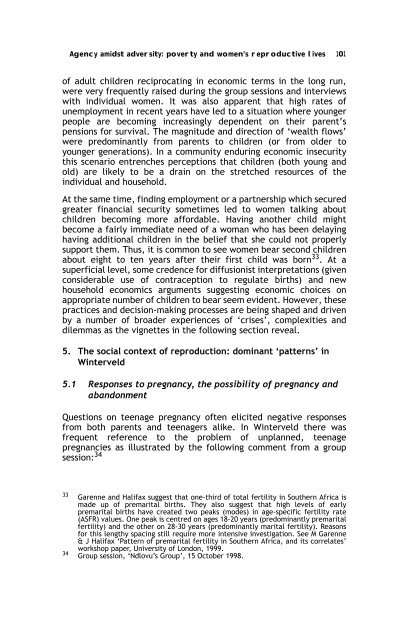Sex, Gender, Becoming - PULP
Sex, Gender, Becoming - PULP
Sex, Gender, Becoming - PULP
You also want an ePaper? Increase the reach of your titles
YUMPU automatically turns print PDFs into web optimized ePapers that Google loves.
Agency amidst adversity: poverty and women’s reproductive lives 101<br />
of adult children reciprocating in economic terms in the long run,<br />
were very frequently raised during the group sessions and interviews<br />
with individual women. It was also apparent that high rates of<br />
unemployment in recent years have led to a situation where younger<br />
people are becoming increasingly dependent on their parent’s<br />
pensions for survival. The magnitude and direction of ‘wealth flows’<br />
were predominantly from parents to children (or from older to<br />
younger generations). In a community enduring economic insecurity<br />
this scenario entrenches perceptions that children (both young and<br />
old) are likely to be a drain on the stretched resources of the<br />
individual and household.<br />
At the same time, finding employment or a partnership which secured<br />
greater financial security sometimes led to women talking about<br />
children becoming more affordable. Having another child might<br />
become a fairly immediate need of a woman who has been delaying<br />
having additional children in the belief that she could not properly<br />
support them. Thus, it is common to see women bear second children<br />
about eight to ten years after their first child was born 33 . At a<br />
superficial level, some credence for diffusionist interpretations (given<br />
considerable use of contraception to regulate births) and new<br />
household economics arguments suggesting economic choices on<br />
appropriate number of children to bear seem evident. However, these<br />
practices and decision-making processes are being shaped and driven<br />
by a number of broader experiences of ‘crises’, complexities and<br />
dilemmas as the vignettes in the following section reveal.<br />
5. The social context of reproduction: dominant ‘patterns’ in<br />
Winterveld<br />
5.1 Responses to pregnancy, the possibility of pregnancy and<br />
abandonment<br />
Questions on teenage pregnancy often elicited negative responses<br />
from both parents and teenagers alike. In Winterveld there was<br />
frequent reference to the problem of unplanned, teenage<br />
pregnancies as illustrated by the following comment from a group<br />
session: 34<br />
33 Garenne and Halifax suggest that one-third of total fertility in Southern Africa is<br />
made up of premarital births. They also suggest that high levels of early<br />
premarital births have created two peaks (modes) in age-specific fertility rate<br />
(ASFR) values. One peak is centred on ages 18-20 years (predominantly premarital<br />
fertility) and the other on 28-30 years (predominantly marital fertility). Reasons<br />
for this lengthy spacing still require more intensive investigation. See M Garenne<br />
& J Halifax ‘Pattern of premarital fertility in Southern Africa, and its correlates’<br />
workshop paper, University of London, 1999.<br />
34 Group session, ‘Ndlovu’s Group’, 15 October 1998.
















